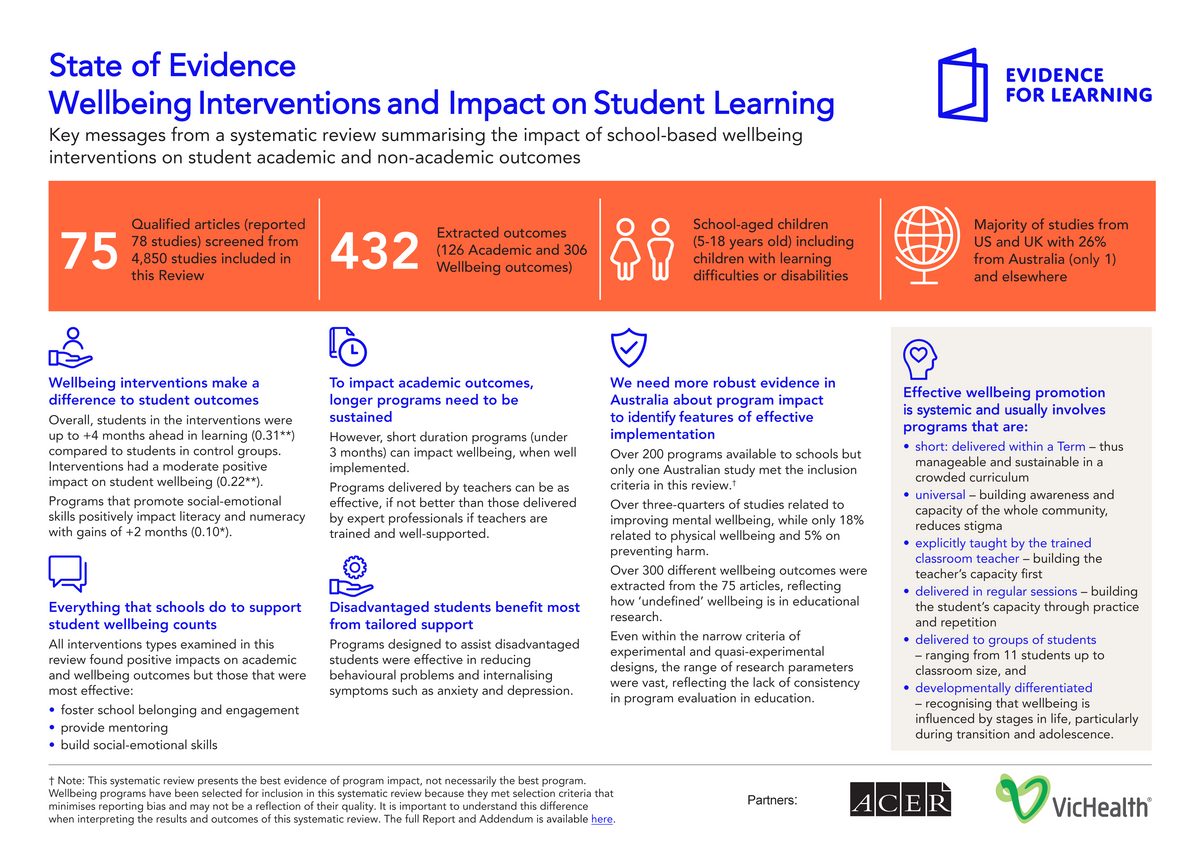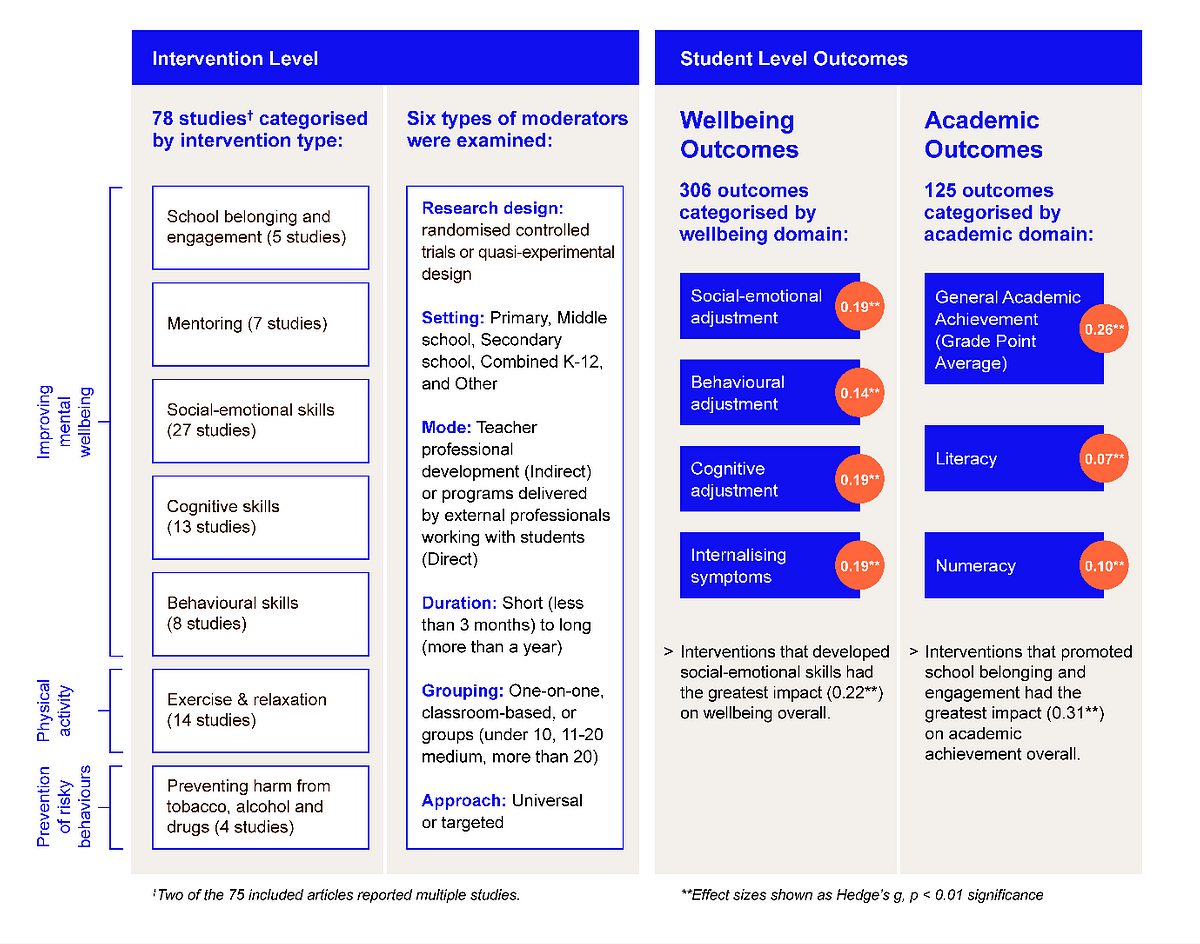Many interventions have been developed to promote health and wellbeing among children and young people in schools. There is a general consensus that school-based well-being programs have the potential to help students attain social-emotional skills they need to succeed academically, but the research of this impact on learning is limited.
This systematic review aims to appraise the state of the evidence to explore the impact on academic achievement and related health and wellbeing measures for all students. Evidence that is relevant for students from disadvantaged backgrounds will be highlighted. The review is commissioned by Evidence for Learning and conducted by the Australian Council for Educational Research (ACER) in partnership with VicHealth.
Eligibility criteria for selecting studies included randomised controlled trials (RCTs), experimental and quasi-experimental studies comparing school-based wellbeing interventions with ‘business as usual’, typically delivered in a classroom context. Included studied involved school-aged children (5−18 years old), had measures of academic achievement and wellbeing (in the broadest sense), and was written in English. This review adapted an Australian government framework of strategic imperatives for health and wellbeing promotion that related to improving mental wellbeing, encouraging physical activity, and preventing harm from substance abuse.
The primary outcome for the included studies is academic achievement (e.g. Literacy, Numeracy). Studies that only report wellbeing outcomes and not academic outcomes are excluded from the review. Secondary outcomes for the included studies, if reported, are mental health and wellbeing outcomes (e.g. physical, resilience, SEL skills, learning difficulties). The search is limited to a publication date range of January 2004 to January 2019 (inclusive).
1. This review found that school-based wellbeing programs had small to moderate positive impacts on student academic achievement, compared to similar students in control groups engaged in their usual activities with general academic performance equivalent to three months of additional learning gain (g = 0.26), numeracy achievement equivalent to two months gain (g = 0.10), and literacy achievement equivalent to one month gain (g = 0.07). Wellbeing programs had small to moderate effects on wellbeing-related measures: social-emotional adjustment (g = 0.14), behavioural adjustment (g = 0.15), cognitive adjustment (g = 0.18), and a moderate impact on internalising symptoms (g = 0.20) compared to students in control groups, consistent with previous reviews.
2. Evidence showed that specific student belonging and engagement programs in school had the greatest impact on academic achievement. Programs that supported social-emotional skills were more effective for promoting student wellbeing and were associated with better literacy outcomes and those that encouraged physical activity, exercise and relaxation were associated with better numeracy outcomes.
3. Research indicated that students from disadvantaged backgrounds may benefit most from a combination of universal whole-school programs supported by targeted programs. Findings were not conclusive and should be interpreted with caution for interventions targeting students with special needs, as the effect was not statistically significant.
4. Evidence suggests that wellbeing programs delivered by ‘trained’ classroom teachers (e.g., a program designed to build the capacity of the teacher first, supported by resources for students) were marginally more effective in impacting students’ wellbeing outcomes than programs delivered by external professionals. This finding highlights the importance of teacher professional learning and their essential role and capacity to influence student wellbeing outcomes. No difference was found on academic outcomes due to the mode of delivery.
5. Programs designed for Secondary schools (of which there were relatively few) appeared to have greater impact on outcomes than programs in other settings (e.g., Primary school), as did universal programs (versus targeted) delivered to students in medium-sized groupings of 11 to 20 students (versus one-on-one or large groups). students in medium-sized groupings of 11 to 20 students (versus one-on-one or large groups).
6. While the quality of included studies is among the best in the field of educational RCT and quasi-experimental designs, there is still a high risk of bias due to the inability to blind participants, study personnel and outcome assessment. It reflects the often, unavoidable complexities in educational research.
7. While there is a plethora of wellbeing programs and interventions available for schools to implement, only one Australian study was included in this systematic review which suggests that high-quality studies using robust research designs are scarce. There is also an increasing need to demonstrate evidence of impact for program funding. More high-quality program evaluations are needed across Australia in order to identify programs that show promise or validate those that are widely used.
The review highlights five key messages:
- Wellbeing interventions make a difference to student outcomes
- Everything that schools do to support student wellbeing counts but some are more effective than others
- To impact academic outcomes, longer programs need to be sustained
- Disadvantaged students benefit most from tailored support
- We need more robust evidence in Australia about program impact to identify features of effective implementation.

Infographic of the key messages
Uploaded: • 3.7 MB - pdfAn interactive version of the Impact Map with estimates of months learning gain and the evidence behind the results are available here. Detailed results and full presentation of the risk analyses can be found in the report.

The outcomes overview model shows how the interventions were grouped, the moderators examined the results of the impact on academic and non-academic outcomes.

The following reports are free to access and download.
Executive Summary
Uploaded: • 1.0 MB - pdfMain Report
Uploaded: • 2.6 MB - pdfAddendum
Uploaded: • 1.1 MB - pdfProtocol
Uploaded: • 396.4 KB - pdfThis review was conducted by the Australian Council for Educational Research (ACER) in partnership with VicHealth.
This Review report and supporting materials are licensed under a Creative Commons licence as outlined below. Permission may be granted for derivatives, please contact Evidence for Learning for more information.

This work is licensed under a Creative Commons Attribution-NonCommercial-NoDerivatives 4.0 International Licence.